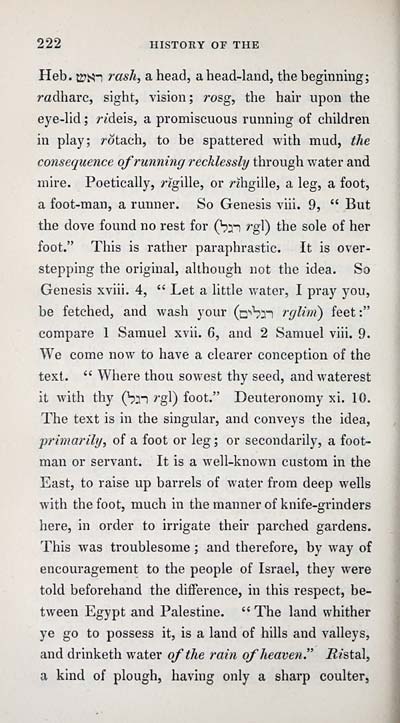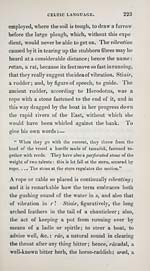Download files
Complete book:
Individual page:
Thumbnail gallery: Grid view | List view

222 HISTORY OF THE
Heb. a)S"i rash, ahead, a head-land, thebeginnmg;
radharc, sight, vision; rosg, the hair upon the
eye-Hd ; r«deis, a promiscuous running of children
in play; rotach, to be spattered with mud, the
consequence ofrunnìng recklessly through water and
mire. Poetically, ngille, or rzhgille, a leg, a foot,
a foot-man, a runner. So Genesis viii. 9, " But
the dove found no rest for (ba"-i rg\) the sole of her
foot." This is rather paraphrastic. It is over-
stepping the original, although not the idea. So
Genesis xviii. 4, " Let a little water, I pray you,
be fetched, and wash your (a'^bai rglim') feet :"
compare 1 Samuel xvii. 6, and 2 Samuel viii. 9.
We come now to have a clearer conception of the
text. " Where thou sowest thy seed, andwaterest
it with thy (bm ?'gl) foot." Deuteronomy xi. 10.
The text is in the singular, and conveys the idea,
primarily, of a foot or leg ; or secondarily, a foot-
man or servant. It is a well-known custom in the
East, to raise up barrels of water from deep wells
with the foot, much in tlie manner of knife-grinders
here, in order to irrigate their parched gardens.
This was troublesome ; and therefore, by way of
encouragement to the people of Israel, they were
told beforehand the difference, in this respect, be-
tween Egypt and Palestine. " The land whither
ye go to possess it, is a land of hills and valleys,
and drinketh water ofthe rain ofheaven" jR/stal,
a kind of plough, having only a sharp coulter,
Heb. a)S"i rash, ahead, a head-land, thebeginnmg;
radharc, sight, vision; rosg, the hair upon the
eye-Hd ; r«deis, a promiscuous running of children
in play; rotach, to be spattered with mud, the
consequence ofrunnìng recklessly through water and
mire. Poetically, ngille, or rzhgille, a leg, a foot,
a foot-man, a runner. So Genesis viii. 9, " But
the dove found no rest for (ba"-i rg\) the sole of her
foot." This is rather paraphrastic. It is over-
stepping the original, although not the idea. So
Genesis xviii. 4, " Let a little water, I pray you,
be fetched, and wash your (a'^bai rglim') feet :"
compare 1 Samuel xvii. 6, and 2 Samuel viii. 9.
We come now to have a clearer conception of the
text. " Where thou sowest thy seed, andwaterest
it with thy (bm ?'gl) foot." Deuteronomy xi. 10.
The text is in the singular, and conveys the idea,
primarily, of a foot or leg ; or secondarily, a foot-
man or servant. It is a well-known custom in the
East, to raise up barrels of water from deep wells
with the foot, much in tlie manner of knife-grinders
here, in order to irrigate their parched gardens.
This was troublesome ; and therefore, by way of
encouragement to the people of Israel, they were
told beforehand the difference, in this respect, be-
tween Egypt and Palestine. " The land whither
ye go to possess it, is a land of hills and valleys,
and drinketh water ofthe rain ofheaven" jR/stal,
a kind of plough, having only a sharp coulter,
Set display mode to: Large image | Transcription
Images and transcriptions on this page, including medium image downloads, may be used under the Creative Commons Attribution 4.0 International Licence unless otherwise stated. ![]()
| Early Gaelic Book Collections > Hew Morrison Collection > Adhamh agus Eubh, no Craobh Sheanachais nan Gàël > (352) |
|---|
| Permanent URL | https://digital.nls.uk/76900914 |
|---|
| Description | A selection of items from a collection of 320 volumes and 30 pamphlets of literary and religious works in Scottish Gaelic. From the personal library of Hew Morrison, the first City Librarian of Edinburgh. |
|---|
| Description | Selected items from five 'Special and Named Printed Collections'. Includes books in Gaelic and other Celtic languages, works about the Gaels, their languages, literature, culture and history. |
|---|

